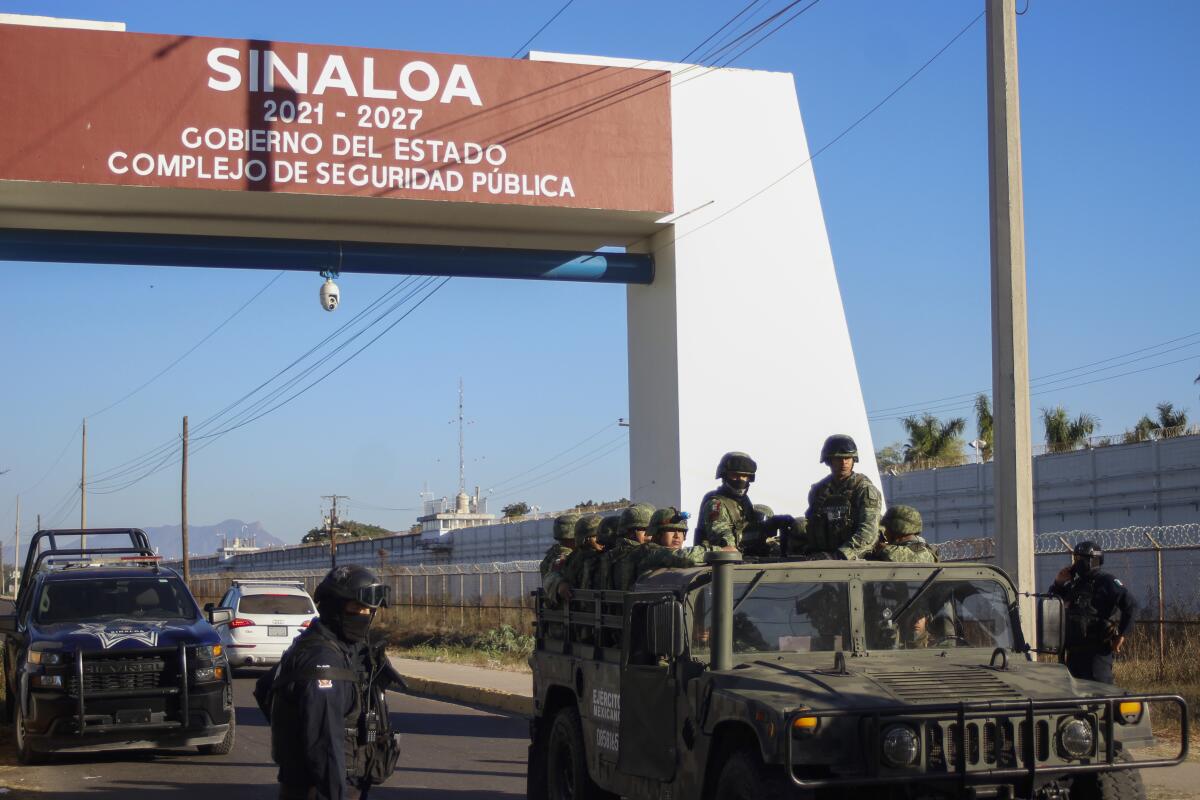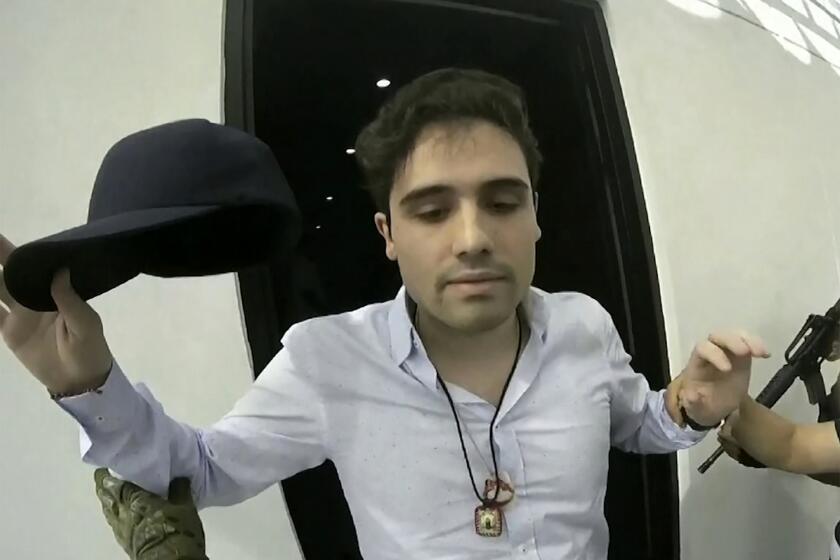Mexico offers blow-by-blow account of the deadly fight to arrest ‘El Chapo’ Guzman’s son

- Share via
MEXICO CITY — The operation to detain Ovidio Guzman, the son of imprisoned drug lord Joaquin “El Chapo” Guzman, unleashed firefights that turned the northern Mexico city of Culiacan into a war zone, authorities said Friday.
In a blow-by-blow description of the battles that killed 10 military personnel and 19 suspected members of the Sinaloa drug cartel, Defense Secretary Luis Cresencio Sandoval said cartel gunmen opened fire on troops with .50-caliber machine guns.
The army responded by calling in Blackhawk helicopter gunships to attack a convoy of 25 cartel vehicles, including truck-mounted cartel gun platforms, on Thursday. The running shootouts killed one Culiacan police officers, and wounded 17 police officers and 35 military personnel.
The cartel then opened fire on the military aircraft, forcing two of them down with “a significant number of impacts” in each of the two aircraft, Sandoval said. The gang then sent hordes of gunmen to attack fixed-wing aircraft, both military and civilian, at the city’s international airport.
In Mexico stronghold of Sinaloa cartel, armed men burn vehicles, storm airport to try to prevent capture of drug lord Joaquín ‘El Chapo’ Guzmán’s son.
One civilian airliner was hit. The gunmen also shot up airport buildings in a bid to prevent the captured cartel boss from being flown out of the city. But, Sandoval said, authorities anticipating the resistance had loaded Ovidio Guzman onto a military helicopter to fly him to Mexico City.
The Mexican administration bagged the high-profile cartel figure days before hosting President Biden.
Samuel González, who founded Mexico’s special prosecutor’s office for organized crime in the 1990s, said Guzmán’s capture was a “gift” ahead of Biden’s visit. The Mexican government “is working to have a calm visit,” he said.
Juan Carlos Ayala, a Culiacan resident and Sinaloa University professor who studies the sociology of drug trafficking, said Ovidio Guzmán had been an obvious target for years.
“Ovidio’s fate had been decided. Moreover, he was identified as the biggest trafficker of fentanyl and the most visible Chapos leader.”
The violent Mexican prison break in which 17 people, mostly guards, died and 30 inmates fled exposes prisoners in charge at the facility near the Texas border.
Ayala said the atmosphere was calmer Friday, “but there are still a lot of burned-out vehicles blocking the streets.”
The scope of Thursday’s violence was such that Sinaloa Gov. Ruben Rocha said cartel gunmen showed up at local hospitals, trying to abduct doctors and take them away to treat wounded fighters. Rocha said that gunmen would be treated if they showed up at hospitals, but they shouldn’t try to abduct medical personnel.
“It got to the point that at one moment the doctors were saying ‘we’re getting out of here’,” recalled Rocha, saying police had reinforced security and convinced the doctors to stay.
Culiacan residents posted video on social media showing convoys of gunmen in pickup trucks and SUVs rolling down boulevards in the city on Thursday. At least one convoy included a flatbed truck with a mounted gun in the back.
Despite the violence, Ayala said, many Culiacan residents may still support the cartel.
That may be because of the money the gang brings to the region, but also because locals know that after federal troops withdraw, the cartel will still be there. As bad as it is, the cartel has ensured relative stability, if not peace.
Ovidio Guzmán was indicted by the United States on drug trafficking charges in 2018. According to both governments, he had assumed a growing role among his brothers in carrying on their father’s business, along with longtime cartel boss Ismael “El Mayo” Zambada.
There was an unspoken pact between narcos and civilians. It broke when ‘El Chapo’s’ son was captured
Culiacan has long been a city of open secrets.
Federal forces had sought in 2019 to take Guzmán into custody, and the cartel responded then as well with a bloody attack on Culiacán. President Andrés Manuel López Obrador eventually ordered Guzmán to be released.
This week, Foreign Affairs Secretary Marcelo Ebrard confirmed that the government had received a request in 2019 from the U.S. for Guzmán’s arrest for purposes of extradition. He said that request would have to be updated and processed, but he added that first an open case in Mexico awaits Guzmán.
Ismael Bojorquez, director of the local news outlet Riodoce, which specializes in coverage of the area’s drug trafficking, said the violent reaction had to do with the Mexican president’s less aggressive stance toward organized crime.
“They [cartels] have taken advantage of these four years to organize themselves, arm themselves, strengthen their structures, their finances,” he said. “I believe there are more weapons than three years ago. All of organized crime’s armies have strengthened, not just the Chapitos, and this is the price that society is paying for this strategy of the federal government.”
Los Angeles Times staff contributed to this report.
More to Read
Sign up for Essential California
The most important California stories and recommendations in your inbox every morning.
You may occasionally receive promotional content from the Los Angeles Times.
















